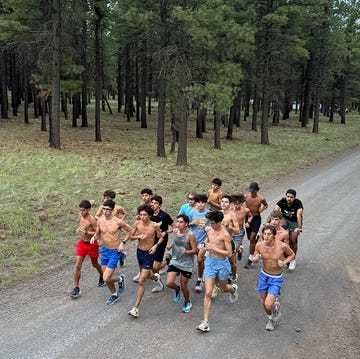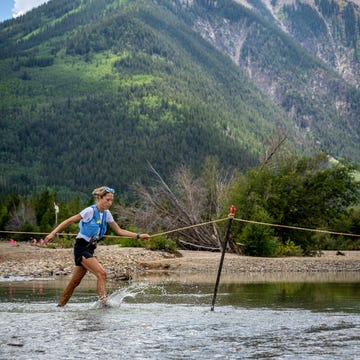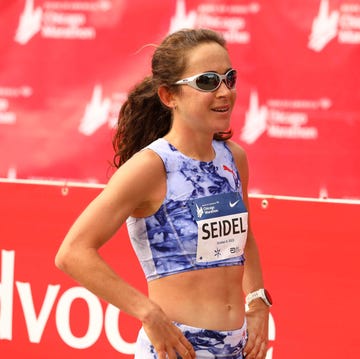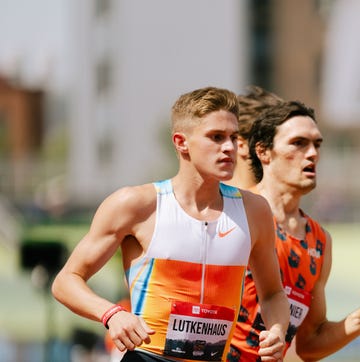In Paris on August 7, after Noah Lyles finished second in his semifinal heat of the 200 meters, he did not stop to talk to media in the mixed zone.
That was unusual for Lyles. The 2023 World Champion and American record-holder in the 200 meters isn’t one to pass up the opportunity to speak. Instead, he was reported to be seeking medical treatment.
And one day later, after the final of the 200 meters, the world knows why. Lyles tested positive for COVID on the morning of August 6, he told trackside reporter Lewis Johnson of NBC after the final.
Letsile Tebogo of Botswana won in 19.46, Kenny Bednarek of the United States was second in 19.62, and Lyles was third in 19.70.
Lyles left the track in a wheelchair, but he went through the mixed zone, the subterranean room at Stade de France where athletes talk to the media, on foot. He was masked as he answered questions from reporters.
He said he started to feel poorly at about 5 a.m. on August 6, with a fever, chills and a sore throat. A test revealed COVID. But Lyles said it was “never a thought” not to compete and he said by the 200-meter final on August 8, he was at about 90 to 95 percent health. Lyles is taking Paxlovid.
He kept his diagnosis very private, so as not to give an advantage to his competitors.
All this begs the question: What are the rules about competing at the Olympics with COVID?
Short answer: It’s up to the athlete.
Scientific American reported that the Paris Games are treating COVID like any other respiratory illness. There are single rooms in the Olympic Village for athletes who have COVID. And athletes who are sick are encouraged to wear masks, wash their hands frequently, and avoid contact with others.
Lani Pallister, an Australian swimmer who contracted COVID, withdrew from the 1500 meters in order to save energy for a later race. An unnamed Australian water polo player was isolating after getting sick, but Anna Meares, the head of the Australian Olympic delegation, said in an article on the Olympic news service, “I need to emphasize that we are treating COVID no differently to other bugs like the flu. This is not Tokyo.”
At the 2021 Games in Tokyo, athletes were subject to frequent testing, and they competed in empty stadiums and arenas, as fans were not allowed to attend.
Athletes who have talked to reporters in the track’s mixed zone said illnesses was circulating through the athletes at the Olympic Village. Jakob Ingebrigtsen spoke to media after the 1500 meters wearing a mask, thought to be a precaution. Grant Fisher, who won bronze in the 10,000 meters, was not staying in the Village and in fact went back to altitude in St. Moritz, Switzerland, before the start of the 5,000 meters.
Immediately after the 200-meter final Lyles, who won the 100 meters, said it was unclear whether he would compete on the 4 x 100-meter relay team for the U.S. “I’m going to be honest and transparent with them and let them make the decision,” Lyles said. “I believe that no matter what happens, this 4 x 100 team can handle anything.”
A few hours later, Lyles wrote on Instagram, “I believe this will be the end of my 2024 Olympics.”
In a written statement, USA Track & Field wrote, in part, “Our primary commitment is to ensure the safety of Team USA athletes while upholding their right to compete. After a thorough medical evaluation, Noah chose to compete tonight. We respect his decision and will continue to monitor his condition closely.
As an organization, we are rigorously adhering to CDC, USOPC, and IOC guidelines for respiratory illnesses to prevent the spread of illness among team members, safeguarding their health and performance.”
Kenny Bednarek, the silver medalist, said he hadn’t noticed a lot of cases of COVID going around the Olympic Village in Paris. He didn’t know that Lyles had COVID before the race and said that it didn’t bother him.
“Sometimes I’m just carefree and minding my own business,” Bednarek said. “There was a message that there was something going around, but I haven’t seen anything.”
As previously reported in Runner’s World, rushing back to running and exercise after you’ve had COVID isn’t always the best idea.
In May 2023, researchers published a literature review in Frontiers in Physiology to determine if high-intensity activity could be dangerous for someone with COVID infection. While intense exercise does come with benefits—such as improved cardiovascular function and metabolic health—they concluded that during and after a COVID infection, intense exercise influences the levels of stress hormones (adrenaline, noradrenaline, and dopamine), which may make COVID symptoms more severe.
—Brian Dalek contributed to this report.

Sarah Lorge Butler is a writer and editor living in Eugene, Oregon, and her stories about the sport, its trends, and fascinating individuals have appeared in Runner’s World since 2005. She is the author of two popular fitness books, Run Your Butt Off! and Walk Your Butt Off!













